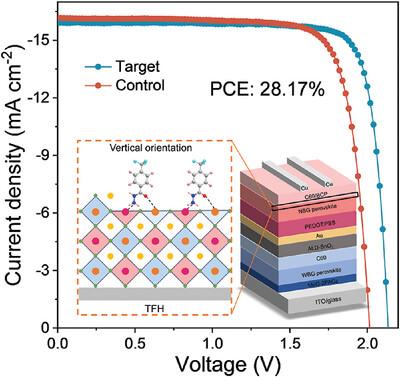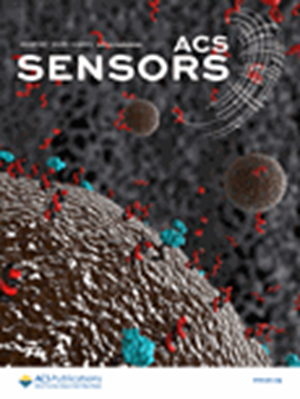实现垂直分子定向的双位点锚链,用于高效全过氧化物串联太阳能电池
IF 8.2
1区 化学
Q1 CHEMISTRY, ANALYTICAL
引用次数: 0
摘要
全过氧化物串联太阳能电池(TSC)因其有望超越单结太阳能电池的效率极限而日益受到关注。然而,作为底层低带隙子电池,锡铅(Sn-Pb)包晶石由于易氧化和晶体形态不佳,在界面上存在严重的非辐射重组问题。据报道,一种表面改性剂 4-(三氟甲基)苯肼(TFH)可在包晶石薄膜表面构建还原性化学环境,保护其免受水和氧气的侵蚀。TFH 通过双位点结合,以优选的垂直方向锚定在锡铅包晶上,形成界面偶极子,促进电荷萃取。TFH 的还原肼基团能有效抑制 Sn2+ 和 I- 的氧化,从而降低 Sn─Pb 包晶石的缺陷密度和能量失调。因此,经过 TFH 处理的器件实现了 22.88% 的冠军 PCE,在连续单太阳光照射 500 小时后仍能保持 93% 以上的初始效率。本文章由计算机程序翻译,如有差异,请以英文原文为准。

Dual-Site Anchors Enabling Vertical Molecular Orientation for Efficient All-Perovskite Tandem Solar Cells
All-perovskite tandem solar cells (TSCs) are gaining increasing attention due to their potential to surpass the efficiency limit of single-junction solar cells. However, as the bottom low-bandgap subcells, tin-lead (Sn-Pb) perovskites suffer from severe nonradiative recombination at the interfaces due to their susceptibility to oxidation and poor crystalline morphology. Here a surface modifier 4-(trifluoromethyl)benzhydrazide (TFH) is reported to construct a reductive chemical environment on the surface of perovskite films and protect them from water and oxygen erosion. TFH anchors onto the Sn-Pb perovskites in a preferred vertical orientation through dual-site binding, forming interface dipoles that facilitate charge extraction. The reductive hydrazine groups of TFH can effectively inhibit the oxidation of Sn2+ and I−, thereby reducing the defect density and energy disorder of Sn─Pb perovskites. Consequently, the TFH-treated devices achieved a champion PCE of 22.88%, maintaining over 93% of the initial efficiency after continuous one-sun illumination for 500 h. Combined with a 1.79 eV wide-bandgap subcell, it has demonstrated a PCE of 28.17% in all-perovskite TSCs.
求助全文
通过发布文献求助,成功后即可免费获取论文全文。
去求助
来源期刊

ACS Sensors
Chemical Engineering-Bioengineering
CiteScore
14.50
自引率
3.40%
发文量
372
期刊介绍:
ACS Sensors is a peer-reviewed research journal that focuses on the dissemination of new and original knowledge in the field of sensor science, particularly those that selectively sense chemical or biological species or processes. The journal covers a broad range of topics, including but not limited to biosensors, chemical sensors, gas sensors, intracellular sensors, single molecule sensors, cell chips, and microfluidic devices. It aims to publish articles that address conceptual advances in sensing technology applicable to various types of analytes or application papers that report on the use of existing sensing concepts in new ways or for new analytes.
 求助内容:
求助内容: 应助结果提醒方式:
应助结果提醒方式:


